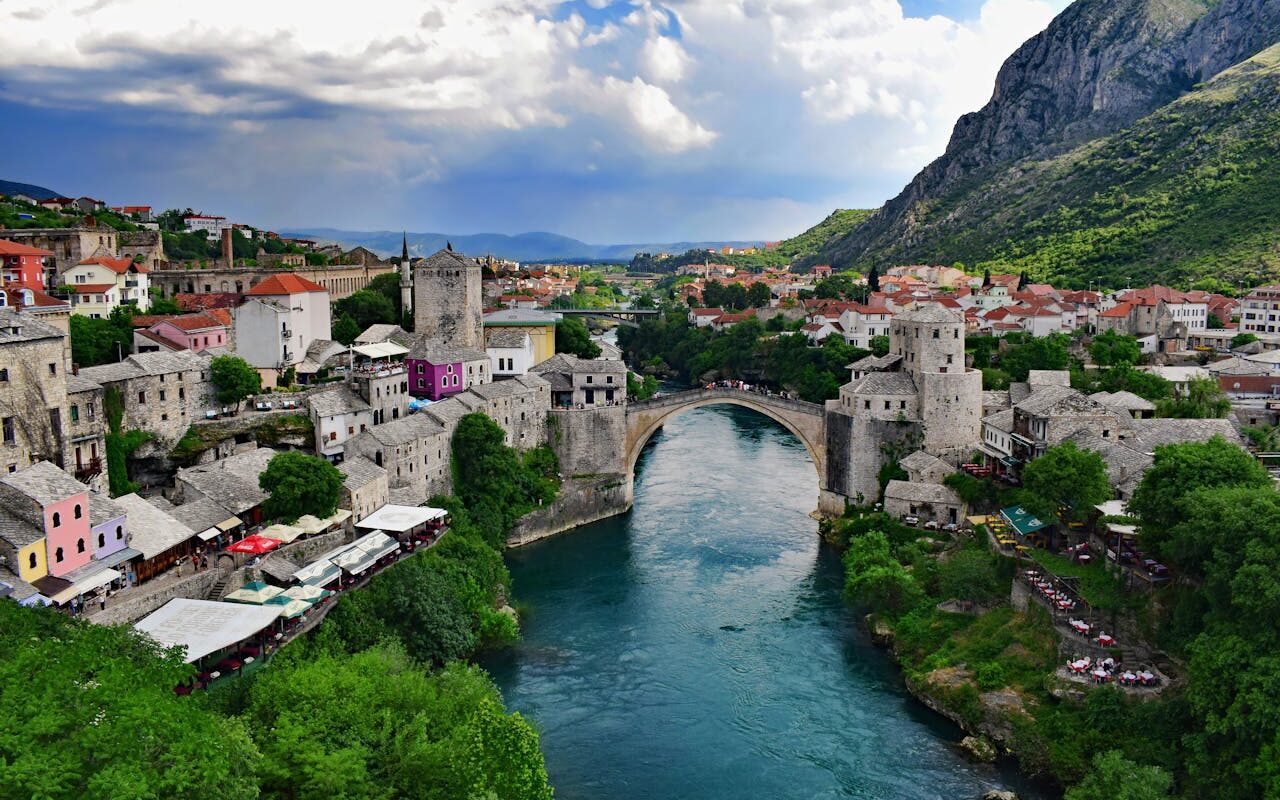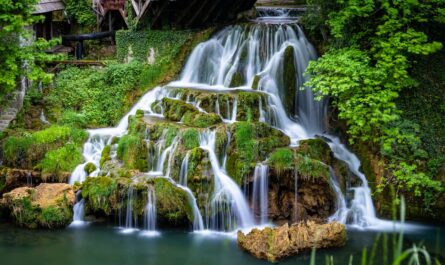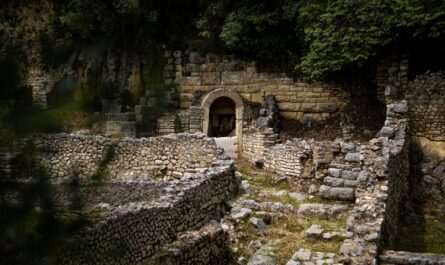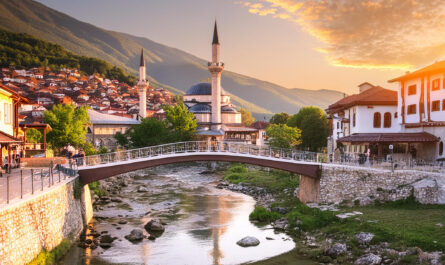Nestled in the heart of Bosnia and Herzegovina, the picturesque city of Mostar is home to one of the most iconic and historically significant bridges in the world – Stari Most. This architectural marvel not only spans the Neretva River but also bridges the gap between cultures, connecting the past and the present in a seamless blend of beauty and history.
Historical Significance
Stari Most, translated as “Old Bridge,” has a rich history dating back to the 16th century. Commissioned by the Ottoman ruler Suleiman the Magnificent, the bridge was designed by the architect Mimar Hayruddin. Completed in 1566, Stari Most stood as a testament to Ottoman engineering and architectural prowess.
For centuries, the bridge served as a vital link between the two sides of Mostar, facilitating trade and cultural exchange. However, the turbulent events of the 20th century took their toll on this architectural gem. During the Bosnian War in the 1990s, Stari Most was tragically destroyed by shelling, leaving the city and its inhabitants in despair.
Reconstruction and UNESCO Recognition
The destruction of Stari Most was a devastating blow to the cultural heritage of Mostar, but it sparked an international effort to rebuild this symbol of unity. In 2004, with funding from various countries and organizations, a meticulous reconstruction project began, using traditional construction methods and materials.
The reconstructed Stari Most was unveiled in 2004, capturing the essence of the original bridge while incorporating modern engineering techniques. The completion of this project not only restored a vital crossing point but also symbolized the resilience of Mostar’s people and their commitment to preserving their cultural heritage.
In recognition of its cultural significance, Stari Most, along with the Old Bazaar area of Mostar, was inscribed as a UNESCO World Heritage Site in 2005. This acknowledgment highlights the importance of the bridge as a symbol of tolerance, multiculturalism, and historical continuity.
Architectural Marvel
Stari Most is a prime example of Ottoman bridge design, characterized by its graceful arch and humpbacked profile. The bridge spans a length of 28 meters and stands at a height of 24 meters, making it a remarkable feat of engineering for its time.
The bridge is constructed using local stone, and its elegant design reflects the cultural fusion of the Ottoman and Mediterranean influences present in Mostar. Stari Most not only serves as a functional crossing but also as a stunning visual spectacle, attracting tourists and photographers from around the world.
Cultural Symbolism
Stari Most is more than just a bridge; it is a symbol of unity, resilience, and the enduring spirit of Mostar. The bridge’s significance extends beyond its architectural beauty, as it represents the harmony between different cultures and religions that have coexisted in Mostar for centuries.
The annual diving competition held at Stari Most is a testament to its cultural significance. Brave locals and international divers plunge into the Neretva River from the bridge’s apex, showcasing the daring spirit and traditions that have thrived in Mostar for generations.
Bridge of Diversities
Stari Most not only physically connects the two sides of the Neretva River but also symbolizes the coming together of diverse communities. Mostar has been a melting pot of cultures, with influences from the Ottoman Empire, Austro-Hungarian rule, and the former Yugoslavia. As you traverse the bridge, you can witness a seamless blend of architectural styles, reflecting the city’s vibrant history.
Ottoman Legacy
Stari Most’s architectural elegance is a testament to Ottoman ingenuity. The bridge’s single stone arch and slender towers exemplify the Ottoman architectural style prevalent during the 16th century. As you walk across Stari Most, you’re transported back in time, experiencing the craftsmanship of a bygone era.
The Breathtaking Views
Stari Most offers panoramic views of Mostar’s old town, with its red-roofed houses and narrow, winding streets. The surrounding landscape, adorned with lush greenery and the meandering Neretva River, provides a stunning backdrop for photographs and a serene atmosphere for contemplation.
The Symbolic Diving Tradition
One cannot discuss Stari Most without delving into the daring tradition of bridge diving. Locals, known as “Mostari,” have been diving from the bridge for centuries. The annual diving competition attracts participants from around the world, each eager to display their courage by plunging into the cold waters of the Neretva River from the bridge’s apex. This tradition adds a dynamic and exhilarating element to the bridge’s cultural significance.
Mostar’s Renaissance
Stari Most’s reconstruction marked a turning point for Mostar, symbolizing the city’s renaissance and rejuvenation. The bridge has become a focal point for cultural events, festivals, and gatherings, fostering a sense of community and pride among Mostar’s residents.
Preservation Challenges
While Stari Most has stood the test of time, it faces challenges related to preservation and conservation. The constant flow of tourists and environmental factors pose threats to the bridge’s structural integrity. Ongoing efforts are crucial to ensuring that this architectural gem continues to inspire awe for generations to come.
Visitor Experience
A visit to Mostar is incomplete without a stroll across Stari Most. Whether you’re exploring the ancient streets of the old town, savoring traditional Bosnian cuisine in riverside cafes, or admiring the talented artisans in the bazaar, Stari Most is the central hub that ties together Mostar’s cultural tapestry.
Bridge of Reconciliation
Stari Most not only serves as a physical connection but also stands as a powerful symbol of reconciliation. In a city marked by the scars of war, the rebuilt bridge bridges the gap between communities, fostering a spirit of unity and understanding. Stari Most serves as a poignant reminder of the importance of healing and coming together after periods of conflict.
Cultural Festivals and Events
Throughout the year, Stari Most becomes a focal point for various cultural festivals and events. The bridge provides a stage for traditional music performances, art exhibitions, and folklore celebrations, creating an atmosphere that celebrates Mostar’s rich cultural tapestry. Locals and visitors alike gather on the bridge to partake in these events, creating a sense of shared identity and appreciation for diversity.
Architectural Symbolism
Stari Most’s humpbacked design is not just an aesthetic choice; it holds architectural significance. The curvature of the bridge is intentional, allowing for better weight distribution and increased stability. This engineering marvel, combined with the use of local stone, showcases the seamless integration of functionality and beauty in Ottoman architecture.
Local Stories and Legends
Stari Most is steeped in local folklore and legends, adding a layer of mystique to its already captivating presence. One such tale involves a young man who, in an attempt to win the heart of his beloved, leaped from the bridge into the Neretva River. While the outcome of his daring feat is lost to history, the story lives on, adding a romantic and adventurous allure to the bridge.
Ongoing Preservation Efforts
Preserving Stari Most requires a delicate balance between allowing access to visitors and protecting its historical integrity. Ongoing preservation efforts involve regular maintenance, monitoring the impact of tourism, and implementing measures to ensure the bridge’s long-term sustainability. These initiatives are crucial to safeguarding Stari Most for future generations.
Beyond the Bridge
While Stari Most is undeniably the jewel in Mostar’s crown, exploring the city beyond the bridge reveals hidden gems. The diverse architecture, the welcoming locals, and the vibrant markets all contribute to the city’s charm. Mostar’s museums and historic sites, such as the Koski Mehmed Pasha Mosque and the Old Bazaar, provide deeper insights into the city’s layered history.
Final Thoughts
Stari Most is not just a physical structure; it’s a living, breathing testament to Mostar’s resilience, diversity, and cultural richness. As it spans the Neretva River, it also spans the chapters of Mostar’s history, connecting the past with the present and creating a bridge to a future of unity, understanding, and shared heritage. Visiting Stari Most is not just a journey across a bridge; it’s a journey through time and culture, inviting all who cross it to be part of Mostar’s continuing narrative.



